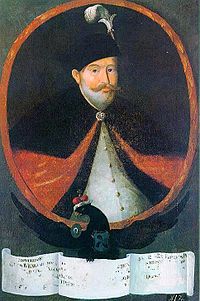Polish–Swedish War (1617–18)
| Polish–Swedish War (1617–1618) | |||||||
|---|---|---|---|---|---|---|---|
| Part of the Polish–Swedish War (1600–1629) and the Polish–Muscovite War |
|||||||
 Grand hetman Krzysztof Radziwiłł "junior" |
|||||||
|
|||||||
| Belligerents | |||||||
|
|
|
||||||
| Commanders and leaders | |||||||
| Gustav Adolphus |
Krzysztof Radziwiłł, Jan Siciński |
||||||
The Polish–Swedish War (1617–18) was a phase of the longer Polish–Swedish War (1600–29). It continued the war of 1600–11 and was an attempt by Sweden to take Polish pressure off Russia. The Polish–Lithuanian Commonwealth was then also fighting Tartars and (on the southern front) the Ottoman Empire. Russia and Sweden were at that stage allied, prior to the Ingrian War, part of the Polish–Muscovite Wars. The 1617–18 war's cause was a dispute over Livonia and Estonia, and a dispute between Sigismund III Vasa and Gustavus Adolphus over the Swedish throne.
After the death of Charles IX of Sweden, Sweden was ruled by his teenage son, Gustavus Adolphus. The young monarch was supported by influential Chancellor Axel Oxenstierna, who in April 1612 agreed to prolong the truce with the Commonwealth until September 1616. At the same time, Polish king Sigismund III Vasa did not renounce Swedish crown (see Polish–Swedish union), and plotted against Gustavus Adolphus, trying to win over Swedish nobility. Sigismund even considered another campaign in Sweden, but failed to do so, due to the ongoing war with Russia.
...
Wikipedia
